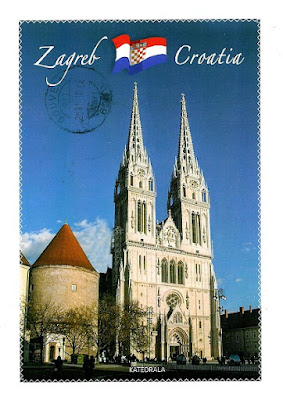
Friday, January 28, 2022
NL-5145605

Thursday, January 27, 2022
Chiemsee Lake - Germany

DE-11351779

Sunday, January 23, 2022
Cologne's Cathedral - Germany
Saturday, January 22, 2022
Writing-on-Stone / Áísínai’pi - Canada
It was because of this card that I tagged Nancy. Writing-on-Stone / Áísínai’pi was the only UNESCO site that I was still missing from Canada.
L'Anse aux Meadows - Canada

Tuesday, January 18, 2022
National Park of American Samoa

Pola Island is an island just offshore from the village of Vatia on Tutuila Island.The island is known for its high cliffs, populated by seabirds, and is one of American Samoa's primary seabird nesting sites.
Rashaida Women - Eritrea
I've tagged Nancy on a UNESCO tag and the she asked me if we could swap a few cards. I said yes and that's how I got this card from Eritrea, a new country in my collection 😃

Friday, January 14, 2022
Red foxes
Chaves Church - Portugal
Paula also sent me a non Christmas card to wish me happy holidays. I believe that all the cards that I've posted from Church were about the roman bridge. Today I'm showing the city's parish church.

1st of May Park in V. N. de Famalicão - Portugal
I liked all the Christmas cards I received last year, of course I did, but the best card of the year award goes to this one that isn't even a Christmas card. This was really the card that I liked the most to receive. It was sent by Miguel, Oscar's son 😍 I loved it!!
The postcard is from Vila Nova de Famalicão, where I've never been to, with the exception of the bus terminal, and from where I only have 2 or 3 more postcards. This one shows the 1st of May Garden.
Sunday, January 9, 2022
Monthly Fav. Surprise RR * October '21




Tuesday, January 4, 2022
HR-95874

Labin is a medieval town located in the southeastern part of Istria, on a 320 meters high hill above Rabac. The town developed on the site of a Roman settlement called Albona (“alb” meaning hill), which was first mentioned in 285 AD. Labin consists of two parts: the old town, which is located on top of the hill, and the new settlement, the so-called Podlabin (“Underlabin”). The combination of the old and new town makes the walk through the streets like a visit to a museum. You can see the town gates from the 15th century, the lodge from the 17th century, renaissance details and baroque facades.





























